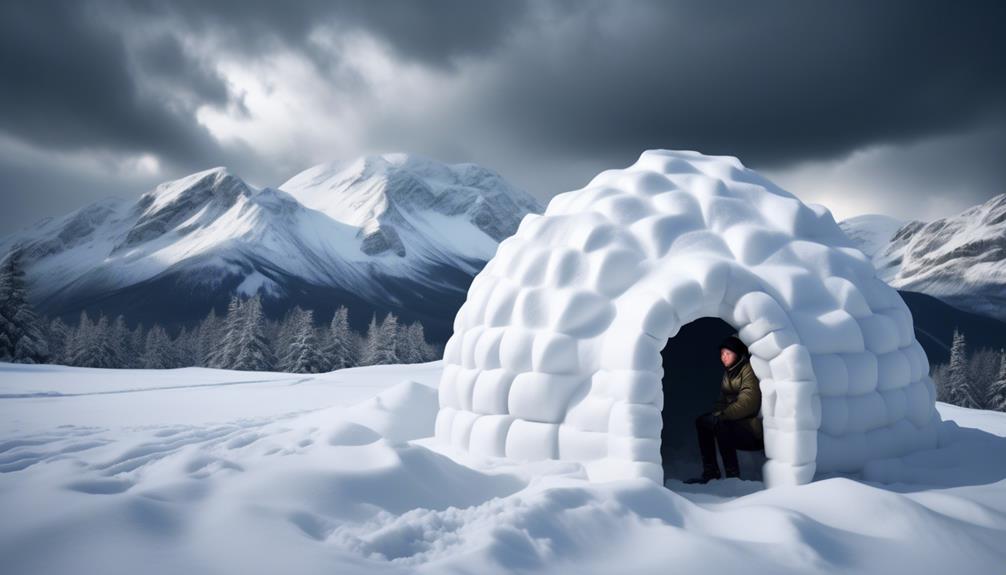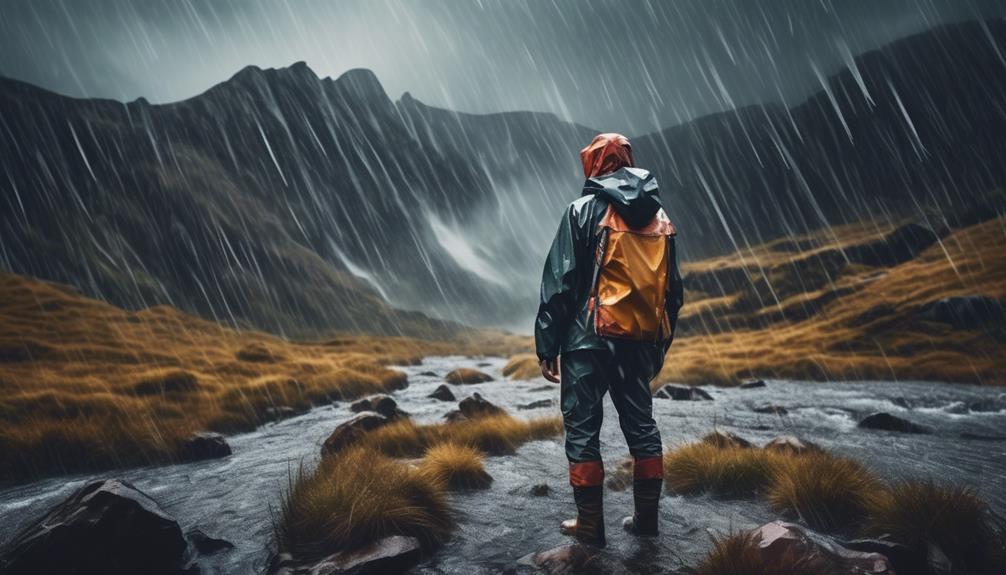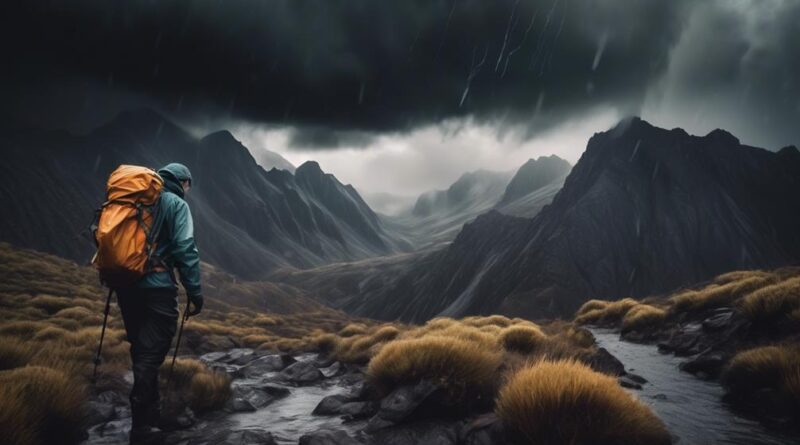Surviving Extreme Weather in the Great Outdoors
Imagine you're out in the wilderness, facing a storm that seems to have a mind of its own. The wind howls like a pack of wolves, and the rain pelts down with unrelenting force.
It's moments like these when your survival skills are put to the ultimate test. You need to know how to adapt and thrive in the face of extreme weather, and that's exactly what we're here to help you with.
With the right knowledge and gear, you can turn the tables on Mother Nature and come out on top.
Shelter Options for Harsh Conditions

When facing harsh outdoor conditions, your primary concern should be finding or creating a sturdy and protective shelter. In extreme weather, a reliable shelter is essential for your safety and well-being.
One of the most common and effective options is a tent. Ensure it's made of durable, waterproof material and properly staked to withstand strong winds and heavy rain.
If you find yourself without a tent, consider building a makeshift shelter using natural materials like branches, leaves, and foliage. This can provide temporary protection from the elements.
Another option is to look for natural formations such as caves or overhanging cliffs, but be cautious of potential hazards and wildlife.
In snowy conditions, constructing a snow cave or igloo can offer excellent insulation and protection from the cold.
Always prioritize finding or creating a shelter before darkness falls or weather worsens. Remember to position your shelter away from potential hazards like falling rocks, flooding areas, or unstable terrain. It's crucial to assess the surroundings and choose a location that offers the best protection from the elements.
Insulated Sleeping Gear for Cold Nights
After securing a sturdy shelter to protect yourself from extreme weather, the next crucial step is to ensure you have insulated sleeping gear for cold nights. When facing harsh outdoor conditions, a high-quality sleeping bag rated for low temperatures is essential. Look for a sleeping bag with a temperature rating lower than the expected nighttime temperatures to ensure warmth and comfort.
Down-filled sleeping bags offer excellent insulation and are lightweight, making them ideal for backpacking, but they may lose insulation properties when wet. Synthetic-filled sleeping bags, on the other hand, provide better insulation when wet and are more affordable, although they tend to be bulkier and heavier.
Consider investing in a sleeping pad with a high R-value to provide insulation from the cold ground. Closed-cell foam pads are lightweight and insulate well, while inflatable pads offer more comfort but may be prone to punctures.
Additionally, using a sleeping bag liner can add extra warmth to your sleep system. Remember to wear dry, thermal clothing and a hat to bed to retain body heat.
Waterproof Clothing and Footwear

To stay dry and comfortable in extreme weather, invest in waterproof clothing and footwear to protect yourself from rain, snow, and other moisture. When it comes to waterproof clothing, look for materials like Gore-Tex or eVent that offer both waterproofing and breathability. This will keep you dry from the outside elements while allowing sweat and moisture to escape from the inside. A good waterproof jacket with sealed seams and adjustable hoods will keep the rain out, and waterproof pants will prevent water from seeping in, especially when kneeling or sitting.
Additionally, waterproof gloves and hats are essential to keep your extremities dry.
For footwear, waterproof hiking boots or shoes with Gore-Tex or eVent membranes are ideal for keeping your feet dry on wet trails. Make sure to also wear waterproof gaiters to prevent water from entering the top of your boots, especially when walking through deep snow or puddles.
It's important to properly maintain your waterproof gear by regularly reapplying durable water repellent (DWR) treatments to the outer fabric of your clothing and cleaning your footwear to prevent dirt and oils from clogging the waterproof membranes. Always check for any wear and tear on your waterproof gear and promptly repair any damages to ensure their effectiveness in keeping you dry during extreme weather conditions.
Portable Heating Solutions for Winter Camping
Consider using a portable propane heater to stay warm during winter camping trips. When it comes to portable heating solutions, propane heaters are a popular choice due to their efficiency and ease of use. These heaters are designed to provide a reliable source of heat in outdoor settings, making them ideal for keeping you warm during cold nights in the wilderness.
One of the key advantages of portable propane heaters is their portability. Most models are lightweight and compact, allowing you to easily transport them to your camping site. They're also relatively easy to set up, requiring minimal assembly and operation, which is beneficial when you're out in the elements and need a quick heat source.
Additionally, propane heaters are known for their high heat output, making them effective at warming up small to medium-sized spaces such as tents or outdoor shelters. This is crucial for maintaining a comfortable and safe environment, especially when temperatures drop significantly during winter nights.
However, it's important to prioritize safety when using propane heaters. Always follow the manufacturer's instructions for proper usage and ventilation to prevent the risk of carbon monoxide buildup. It's also advisable to have a carbon monoxide detector in your camping shelter for added safety.
High-Quality Windproof and Thermal Tents

When camping in extreme weather conditions, selecting a high-quality windproof and thermal tent is essential for ensuring protection and warmth during your outdoor adventures. A reliable windproof tent is designed to withstand strong winds, providing stability and preventing the tent from collapsing in harsh weather. Look for tents with sturdy aluminum poles and reinforced guy lines to enhance stability.
Additionally, thermal tents are crucial for retaining heat in cold weather. These tents are equipped with advanced insulation materials and design features that help trap body heat and create a cozy environment inside the tent.
When choosing a windproof and thermal tent, opt for models made from durable and weather-resistant materials such as ripstop nylon or polyester. These materials offer superior protection against wind, rain, and snow while providing long-lasting performance. Moreover, consider tents with a streamlined, aerodynamic shape to minimize wind resistance and improve overall stability during storms. Some tents also feature built-in ventilation systems to prevent condensation and maintain a comfortable interior temperature.
Furthermore, pay attention to the tent's ability to withstand low temperatures. Look for tents with a high hydrostatic head rating to ensure excellent waterproofing and resistance to frost. Additionally, features such as heat-sealed seams and waterproof groundsheets contribute to the overall thermal efficiency of the tent, keeping you warm and dry in challenging weather conditions.
Investing in a high-quality windproof and thermal tent is a crucial step in preparing for outdoor expeditions in extreme weather. Prioritize durability, weather resistance, and thermal performance to stay safe and comfortable during your outdoor adventures.
Emergency Communication and Navigation Devices
Ensure your outdoor safety by equipping yourself with reliable emergency communication and navigation devices. When venturing into the great outdoors, it's crucial to have the right tools to keep you safe and connected in case of emergencies. Here are four essential items to consider adding to your outdoor gear:
- Personal Locator Beacon (PLB): A PLB is a vital distress beacon that uses satellite technology to alert search and rescue teams of your location in the event of an emergency. It's a compact and lightweight device that can be a literal lifesaver when you're in remote areas without cell phone coverage.
- Two-Way Radio: Communication is key in outdoor settings, especially when cell phone signals are unreliable. Invest in a two-way radio that has a long battery life and a wide range. This will allow you to stay in touch with your group or call for help if needed.
- GPS Device: A handheld GPS device is an invaluable tool for navigation in the wilderness. It provides accurate location information, helps you track your route, and can guide you back to safety if you get lost.
- Signal Mirror and Whistle: In addition to electronic devices, carry a signal mirror and a whistle. These low-tech items can be effective for signaling for help over long distances, especially in open terrain.
Frequently Asked Questions
How Can I Protect My Electronic Devices From Extreme Weather Conditions?
You can protect your electronic devices from extreme weather conditions by using waterproof cases, keeping them insulated, and storing them in a secure, dry location when not in use. This will help prevent damage and ensure their functionality.
Are There Any Specific Safety Measures I Should Take When Camping in High-Altitude Areas?
When camping in high-altitude areas, make sure to acclimate slowly, stay hydrated, and protect against sun exposure. Keep an eye on weather changes and have a plan for sudden temperature drops or storms.
What Are the Best Practices for Storing Food in Extreme Weather Conditions?
When storing food in extreme weather, keep it in secure containers to prevent animals from getting to it. Store it away from direct sunlight and in a cool, dry place to maintain freshness and prevent spoilage.
How Can I Prevent Frostbite and Hypothermia in Subzero Temperatures?
To prevent frostbite and hypothermia in subzero temperatures, wear layers, protect exposed skin, and stay dry. Seek shelter and warmth, and avoid alcohol and caffeine, which can increase heat loss. Stay aware of symptoms and act quickly if they occur.
Are There Any Specific Tips for Navigating Through Extreme Weather Conditions Such as Blizzards or Heavy Rain?
When navigating through extreme weather like blizzards or heavy rain, always stay informed about the forecast and be prepared with proper gear. Avoid unnecessary travel and seek shelter if conditions become dangerous. Stay safe!
Conclusion
In conclusion, when facing extreme weather in the great outdoors, it's crucial to be prepared with the right gear and equipment. From shelter options and insulated sleeping gear to waterproof clothing and portable heating solutions, there are plenty of ways to stay safe and comfortable.
Additionally, investing in high-quality windproof and thermal tents, as well as emergency communication and navigation devices, can make all the difference in surviving and enjoying your outdoor adventures.
Stay prepared and stay safe out there!
